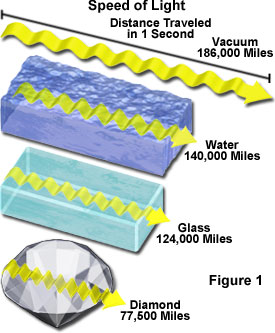Speed of Light in Transparent Materials
Speed of Light in Transparent Materials - Java Tutorial
When light traveling in a vacuum enters a new transparent medium, such as air, water, or glass, the speed is reduced in proportion to the refractive index of the new material. This interactive tutorial explores the reduction in the speed of light as a function of refractive index in common substances.
The tutorial initializes with a light wave traveling through air (simulated by a clear block) at a speed of 186,226.52 miles per second. In order to operate the tutorial, use the Refractive Index of Material slider to change the composition and refractive index of the block between a range of 1.0 and 3.91. As the slider is translated to the right, the refractive index increases and the speed of light subsequently decreases. The refractive indices and names corresponding to common materials are displayed above the slider handle. In addition, the speed of light through a material of the refractive index set by the slider is calculated and displayed beneath the block.
Light traveling in a uniform substance, or medium, propagates in a straight line at a relatively constant speed, unless it is refracted, reflected, diffracted, or perturbed in some other manner. This well-established scientific fact is not a product of the Atomic Age or even the Renaissance, but was originally promoted by the ancient Greek scholar, Euclid, somewhere around 350 BC in his landmark treatise Optica. However, the intensity of light (and other electromagnetic radiation) is inversely proportional to the square of the distance traveled. Thus, after light has traveled twice a given distance, the intensity drops by a factor of four.
When light traveling through the air enters a different medium, such as glass or water, the speed and wavelength of light are reduced (see Figure 1), although the frequency remains unaltered. Light travels at approximately 300,000 kilometers per second in a vacuum, which has a refractive index of 1.0, but it slows down to 225,000 kilometers per second in water (refractive index = 1.3; see Figure 1) and 200,000 kilometers per second in glass (refractive index of 1.5). In diamond, with a relatively high refractive index of 2.4, the speed of light is reduced to a relative crawl (125,000 kilometers per second), being about 60 percent less than its maximum speed in a vacuum.

Because of the enormous journeys that light travels in outer space between galaxies and within the Milky Way, the expanse between stars is measured not in kilometers, but rather light-years, the distance light would travel in a year. A light-year equals 9.5 trillion kilometers or about 5.9 trillion miles. The distance from Earth to the next nearest star beyond our sun, Proxima Centauri, is approximately 4.24 light-years. By comparison, the Milky Way galaxy is estimated to be about 150,000 light-years in diameter, and the distance to the Andromeda galaxy is approximately 2.21 million light-years. This means that light leaving the Andromeda galaxy 2.21 million years ago is just arriving at Earth, unless it was waylaid by reflecting celestial bodies or refracting debris.
When astronomers gaze into the night skies, they are observing a mixture of real time, the recent past, and ancient history. For example, during the period that pioneering Babylonians, Arab astrologers, and Greek astronomers described the stellar constellations, Scorpius (Scorpio to astrologers) still had the whiptail of a scorpion. The tail star and others in this constellation had appeared as novae in the skies between 500 and 1000 BC, but are no longer visible to today's stargazers. Although some of the stars that are observed in the night skies of Earth have long since perished, the light waves that carry their images are still reaching human eyes and telescopes. In effect, the light from their destruction (and the darkness of their absence) has not yet crossed the enormous distances of deep space because of insufficient time.
Sorry, this page is not
available in your country.